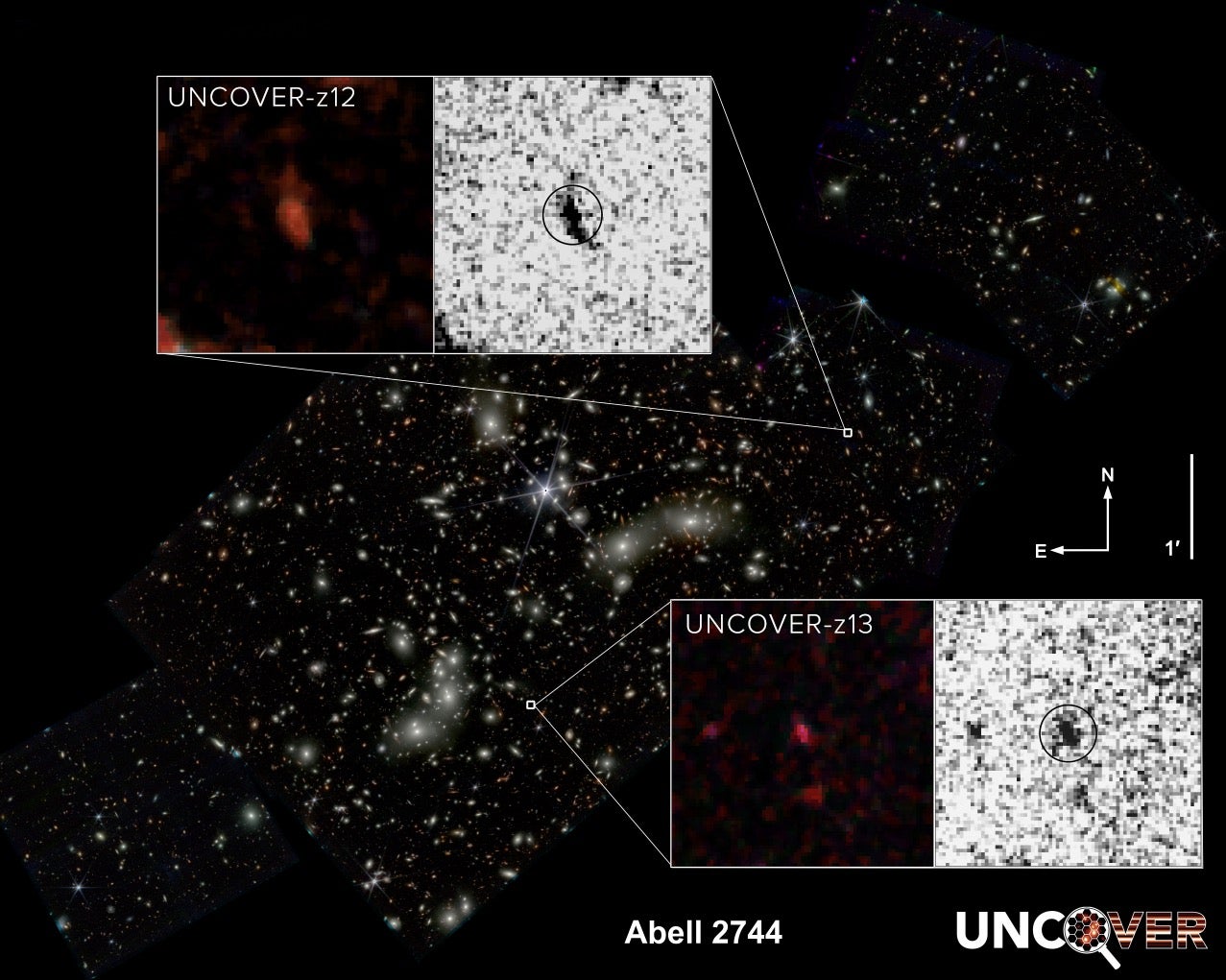
When the James Webb Space Telescope (JWST) launched almost two years ago, it set out to peer into the past and look for primitive galaxies that formed in our early universe. Now, JWST has detected some of the most distant galaxies ever seen (ranked second and fourth) within Pandora’s Cluster (also known as Abell 2744).
Experts analyzing data taken of Pandora’s Cluster from the JWST Ultradeep NIRSpec and NIRCam ObserVations before the Epoch of Reionization (UNCOVER) program earlier this year have detected two ancient background galaxies hidden among thousands of galaxies in the cluster. Even with JWST’s powerful capabilities, galaxies this far typically appear as red specks of light. But these newly discovered ancient galaxies appear to have structure: One looks like an elongated peanut and the other a feathery ball. An analysis of the galaxies was published earlier this month in Astrophysical Journal Letters.
Experts are interested in looking at the farthest galaxies because they can help us understand how the earliest galaxies formed after the Big Bang.
“The light from these galaxies is ancient, about three times older than the Earth,” said study co-author Joel Leja, an astrophysicist at Penn State, in a statement. “These early galaxies are like beacons, with light bursting through the very thin hydrogen gas that made up the early universe. It is only by their light that we can begin to understand the exotic physics that governed the galaxy near the cosmic dawn.”
Stitched together
Pandora’s Cluster is like a colossal natural magnifying lens in front of the universe’s earliest galaxies. The three groups of galaxies found in the region create an intense gravitational lens, whose mass bends and brightens the light of galaxies far behind them and allowing researchers to peer into the past.
The Hubble, Spitzer, and Chandra space telescopes have previously imaged Pandora’s Cluster for NASA’s Frontier Fields program. With JWST, the team collected even deeper views of the cluster.
Related: The Hubble’s discovery of Pandora’s Cluster
“When the images of Pandora’s Cluster first came in from Webb, we were honestly a little starstruck. There was so much detail in the foreground cluster and so many distant lensed galaxies I found myself getting lost in the image. Webb exceeded our expectations,” said Rachel Bezanson, an observational astronomer at the University of Pittsburgh and study co-author, in a statement.
The team ultimately used four images taken by JWST in 2022 to create a new panoramic view of the Pandora Cluster. The image comprises nearly 30 total hours of observing time, split into exposures lasting 4 to 6 hours.
Hidden among thousands
The new galaxies were found after researchers narrowed down the 60,000 points of light within Pandora’s Cluster to 700 galaxies they were interested in studying further. Out of those 700, eight showed promise as early structures. So, the team followed up with JWST’s NIRSpec, focusing on capturing light from just those eight galaxies to determine their distance and other properties.
They found that the two most distant galaxies’ light comes to us from a time when the universe was just 330 million years old. But because the universe can expand faster than the speed of light, these galaxies are actually some 33 billion light-years away.
Using the NIRSPec data, the team used models to determine the galaxies’ mass and physical properties, including their chemical composition. These galaxies contain very few metals (elements heavier than helium), are very young, grew rapidly, and are forming new stars.
“The first elements were forged in the cores of early stars through the process of fusion,” Leja said. “It makes sense that these early galaxies don’t have heavy elements like metals because they were some of the first factories to build those heavy elements. And, of course, they would have to be young and star-forming to be the first galaxies,” he added. “Confirming these properties is an important basic test of our models and helps confirm the whole paradigm of the Big Bang theory.”
Although these were the most distant galaxies identified, if even more distant galaxies were in this target area, JWST’s infrared instruments should have picked them up. So, Leja explained, that either means galaxies couldn’t have formed even earlier, or simply that nothing younger exists in the small region JWST observed.









